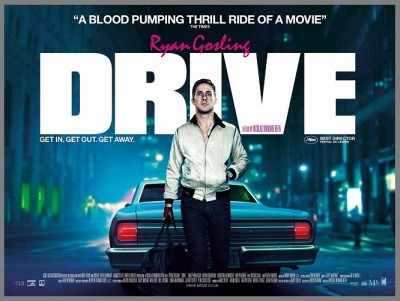“There are no good sharks?”
Part-time stuntman, part-time mechanic, part-time wheelman, and full-time brood—this is Ryan Gosling‘s Driver. He’s a man of few words with determination stamped on his face and a code of morals that exist inside a very murky gray area blurring the line between right and wrong when loyalty comes into play. A very cerebral actioner that harkens back to director Nicolas Winding Refn‘s Valhalla Rising more than Bronson, Drive lives up to its stature of incomparable cool. This thing is slick as hell, existing in a world befitting of its gloved and scorpion-jacket wearing antihero with toothpick firmly clenched in mouth. Stylishly brilliant, though, the attributes making it aesthetically so also sadly give its simple story a sterility to leave you cold and wanting more.
Starting with a bang laden whimper, Gosling and Refn give us a little taste of what’s to come via a chess match car chase through LA. Setting the stage with his trademark speech about allotting five minutes for any crime before locking the doors and gunning it away from the cops, Driver listens to a police radio and the Clippers game simultaneously while waiting for two ski-masked criminals. Riding a souped-up silver Camry—courtesy of friend/boss Shannon (Bryan Cranston)—the vehicle is spotted and chased by land and air. Unnerved and completely in control, Gosling hits the throttle and hits the brake winding through the map in his head to duck down alleys and patiently wait for opportunities to escape. But just as the car under him growls with its pent-up, unbridled, and potentially lethal power, so does the man at the wheel. Cool and collected when playing by his rules, throw a wrench in the system or threaten those close and a storm of rage will uncoil to destroy you.
Despite the revving engine and synth beats of music behind it—I wish I could forget the on-the-nose lyrics, each vocal taking me out of the film—my adrenaline schizophrenically pumped and dissipated throughout. Like this opening chase, the pedal is never depressed to the floor for long before it’s let go for quieter scenes of introspection. This isn’t a bad thing; it’s simply unexpected. We learn about Driver’s skills at the wheel and under the hood by one line of dialogue, a solitary worktable lit up where the TV should sit in his apartment showing how large a part driving is in his life. Besides a wry smirk barely curling the sides of his lips, not much emotion is expressed. A thumbs up after a movie stunt shows he’s okay; a slight nod of the head is enough to accept a job. It’s an existence soon undone by a handful of new people to his life, the film bottled between their introduction and his release from their hold. Past and future are obsolete.
Through Carey Mulligan’s Irene and Kaden Leos’ Benicio, Driver discovers a glimmer of compassion and love. A platonic relationship that teeters towards more, her husband Standard (Oscar Isaac) looms as his prison release nears. Although sexual tension exists between them, the real bond formed is between Gosling’s mysterious man and her little boy. Whether he becomes a fixture in their life or not, he entrenches himself and refuses to let them get hurt—especially from circumstances of his doing. And thus enters Albert Brooks’ Bernie and Ron Perlman’s Nino to the tale. Two Jewish thugs combining brains and brute force, they’re originally enlisted by Shannon to bankroll a racecar. Gosling’s ability to drive is unparalleled, so taking his skills legit seems a no-brainer. Before the endeavor can truly take off, though, Driver finds himself helping Standard with a ‘simple’ job to buy Irene and Benicio’s freedom. It unsurprisingly goes wrong and drags Gosling down from the fringes and into the world he desperately tried to keep at arm’s length.
From here, Refn methodically takes us through Hossein Amini’s script—adapted from a novel by James Sallis. With slow camera pans, extreme close-ups of gorgeously framed abstract shapes, and subtle slomotion sprinkled in at precise moments, the look of Drive is fantastic. Unafraid to linger, the camera becomes our voyeuristic entry into the violence soon seeping in. Bloody, brutal, and uncompromising, the spurts of vicious assault are quick but memorable. Their authentic portrayal could be hard to watch for some, but for me is shown too matter-of-fact. Cold and emotionless, Driver continues on his path of vengeance and survival, crossing people off his list to ensure Irene and her son’s safety. As oddly sterile as the violence is, though, their romance is much of the same. Never fully letting Driver open up or Irene commit adultery, we as an audience can’t invest either. We’re constantly unsure of what’s happening, the jump cuts between cause and effect blurring timeline to make the film more about its form than its story.
And that’s okay. I love how we’re made to watch and understand the horrors of life in the fast lane. It’s either isolation with the rush of adrenaline or love and the constant need to sustain it. A choice must be made when those worlds mix, one whose result can only end in sacrifice. Refn and company excels at creating a character study of this archetype. All the aura of glory we usually associate with this James Dean bad boy is stripped away to leave reality’s truth of pain, suffering, and solitude. To be a hero is not easy; to survive is never without loss. Gosling embodies this interior struggle to perfection—his uncontrollable rage a force—opposite Mulligan’s depressive longing, Brooks’ nuanced menace, and Cranston’s misguided fatherly love. These calculated performances align with the aesthetic to stun visually, but never overcome the desolation. It’s a beautiful work of art lacking the necessary audience connection to make it more than a long-form, stylish music video. Driveis your fun action flick pared down to its stark, real life essence. Perhaps I just wasn’t fully ready for the experience.
Drive 8/10

